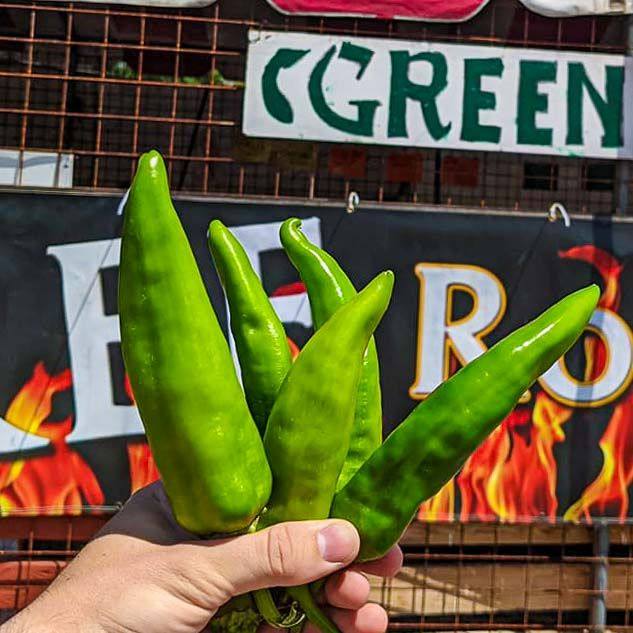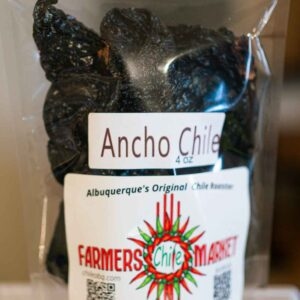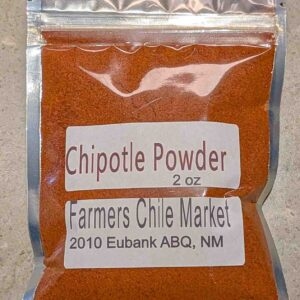Your cart is currently empty!
Different Types of Mexican Chile

Although our primary focus at Farmers Chile Market is New Mexican chile during the chile season, we also carry a lot of other varieties like superhot chili and various types of Mexican chile too. More than just that though, we would be remiss if we did not also respect the amazing chile heritage of our southern neighbor. The state of Chihuahua directly south of New Mexico produces more chile than anywhere else in Mexico. The variety available is also quite immense.
Mild chile
Although Mexican salsas are often famed for heat, many chiles commonly used in Mexico are not.
Poblano, Ancho, and Mulato
For example, if you try Ancho chile, it tastes almost like a raisin, with a lot of sweetness and little heat. After all, chile is just another type of fruit, and ancho is a ripened and dried chile. The Mulato is a further ripened poblano chile, which is even sweeter, but also more spicy.
Chilaca and Pasilla
Another fairly mild chile that is quite common in Mexico is the chilaca pepper. It also has a slight sweetness, with more spice and earthiness than poblano. Dried, it becomes the pasilla pepper, one of the main chiles used in typical Mexican red salsas and mole.
Cascabel
Another chile with light heat, cascabel is one of the more unique looking chiles. It is shaped like a cherry tomato, and keeps its shape when dried, leaving its seeds loose to rattle around inside the shell. It possesses a mild earthiness and a rare nutty flavor that kicks up the soul food feeling of a dish. I often like to make New Mexican red chile sauces with a couple deseeded cascabels for this reason, the flavor is hard to find in anything else.
Guajillo and Mirasol
Perhaps the hottest chile in this section, Guajillo is another chile that is incredibly common in Mexico. When fresh, it is known as mirasol, or sun looking chile. This is because it grows upwards toward the sun instead of down like New Mexico chile. It is a large chile, somewhat comparable in size to our New Mexico Sandia chile. The spice level is somewhat less that a jalapeno, but more than poblano or chilaca chiles. When dried, guajillo is another main chile to use in Mexican red sauces. Many people love to mix guajillo, pasilla, and ancho together to make a nicely balanced sauce for tamales, enchiladas, chilaquiles and much more.
Hot Chile
Jalapeno and Chipotle
The most famous Mexican chile is without a doubt the Jalapeno. It is a very juicy jalapeno with a nice fruitiness and slight sweetness that increases as it ripens. This pepper is found pretty much everywhere in the United States, along with its ripened and smoke dried chipotle counterpart. Just like other Mexican chile, there are multiple varieties of chipotle, with chipotle morita being the most well known. It is smoked to a point where the texture is dry, but still has a little softness and glossy redness. In Mexico, another popular version of chipotle is Chipotle Meco, which is smoked until its color looks more brown, without any shine. It looks similar to tobacco, and smells very smoky. These are often very prized in Mexico, as the flavor is more powerful. Jalapenos and chipotle are not terribly spicy, but still pack a punch enough for spice lovers. They are great chiles for people looking to build up their spice tolerance.
Serrano
Serranos are another type of chile that is found all over the United States. The spice level is typically hotter than Jalapenos, though there is some overlap between spicy jalapenos and mild serranos. A serrano typically is les sweet and more earthy than a jalapeno, along with being less juicy. If you like hot salsas, mix one or two serranos in with some jalapenos to step up the spice level without making too much of a leap. These chiles aren’t commonly dried, as the thin walls make them break apart quite easily. Although one might risk chopping jalapenos without gloves occasionally, serranos and above should definitely use gloves to avoid burning your hands and ruining your night.
Other hot chile
There are many other chiles commonly used in Mexico, but are only found in their own regions. Because they are hard to find even in most areas of Mexico, they can be almost impossible to find abroad.
Extra Hot Mexican Chile
Chile de Arbol
Chile de Arbol is also commonly referred to as chile pequin in New Mexico. This chile is comparable to cayenne pepper. It packs a punch. It is called chile de arbol because of its woody stems. These chiles are very common in salsa picante. A more visual representation is with chile ristras. Because the stems are long and sturdy, they are often tied into special shape ristras such as hearts, crosses, and wreaths.
Chile Tepin
Chile tepin or chiltepin is a very spicy small chile pepper that is said to be one of the original chile pepper species. The size is quite small, but these chiles are a bomb of both flavor and heat. The flavor feels rustic, with earthiness and a dry smoke, with limited sweetness and mild fruit flavor. This chile will wake you up, and even just two or three will elevate a dish to a new level of spice.
Habanero
Although the name suggests that this chile is from Havana, it is more used in Mexico. This is the go to chile Mexican chefs go to when they make their extra-hot salsas. Superhots like ghosts and Carolina reapers still don’t have a huge following in Mexico, and I think it is largely because habaneros are so prevalent in salsa selections in Mexico. Rarely will a restaurant put habanero based salsas on a dish for you, instead just having it available for the brave souls who want to try.
Comparisons of different chile
Guajillo vs New Mexico Chile
A major difference is that guajillo chile grows up towards the sky, where New Mexico chile typically grows down. Additionally, New Mexico chile is far more diverse than guajillo. Guajillo’s spice level is in between a medium to hot chile in New Mexico. Guajillo is a little less spicy than a sandia chile, the chile most often used to make ristras in New Mexico. If you are making a sauce that calls for guajillo chile, a blend of medium and hot dried New Mexico red chile pods is a great substitution! In case you are looking for some extra heat, be sure to try X-hot Barker or XXX-hot Lumbre red chile pods!

Chile de Ristra vs Guajillo
Chile de Ristra is a chile that really depends on what type of ristra it is. In case it is a ristra made with chile pequin AKA chile de arbol it is quite hot, pushing 30,000 Scoville. In this case, they are not really good substitutes for each other. Chile pequin is small, with a long woody stem that is ideal for tying it into various shapes. In case the chile on the ristra is a large pepper, it is likely a Sandia chile, the traditional hot Hatch chile. This chile is a great substitute for guajillo, because it is a comparable size and just a little bit more spicy.

Different ways of eating chile
In New Mexico, we typically roast green chile in a giant barrel roaster, then take it home and bag it up to be frozen and used through the year. In Mexico, fresh green chile peppers like serranos and jalapenos are often roasted up on a flattop grill, to be eaten alongside a taco or other accompanying dish. Mexican eateries typically leave the peel on also, where I don’t know anyone other than tourists who leave the peel on when eating a roasted Hatch chile.

On this note, food bloggers, please stop adding chopped raw New Mexico chile to random dishes. Seeing content like this makes me feel like Uncle Roger when he sees a bad fried rice video. That is fine with many chili peppers, like bell peppers or jalapenos, but New Mexico green chile has a very resilient peel that isn’t suited for this. We ALWAYS roast and peel our green chile before eating it. Red chile has gone through a natural fermentation process that changes the characteristics of the peel, so simply blending it up works great! In New Mexico, we take our green and red chile very seriously, which is why the Hatch Chile Festival is one of our bigger events in the state.

-
 Chile Tepin .75 Oz bag$8.88
Chile Tepin .75 Oz bag$8.88 -
 Ancho Chile – 4oz bag$4.99
Ancho Chile – 4oz bag$4.99 -
 Cascabel Chile$7.99
Cascabel Chile$7.99 -
 Pasilla Chile – 3 oz$4.99
Pasilla Chile – 3 oz$4.99 -
 Guajillo Chile$4.89
Guajillo Chile$4.89 -
 Chipotle Meco$6.99
Chipotle Meco$6.99 -
 Dried Puya Chile$6.69
Dried Puya Chile$6.69 -
 Chipotle Morita$5.45
Chipotle Morita$5.45 -
 Chipotle Powder$3.99
Chipotle Powder$3.99








